Online food delivery service market share wars: Grubhub Vs DoorDash
Introduction:
This case study will analyze the competition between Grubhub and DoorDash - the most popular food delivery platforms in the US. The focal point of study involves history, strategy and lawful battle in their efforts to have more market share.
Background and History of Grubhub:

Grubhub was established in 2004 by two software developers namely Mike Evans and Matt Maloney [1]. They both enjoyed ordering food online but found that the process was often complicated and time-consuming. They noticed that there was a need to create a platform that could make it easier for people to order food online from different localized restaurants. Maloney and Evans designed Grubhub by developing a simple website where buyers could search the nearby restaurants and order food online. Over time, the website got instant success to sign up new restaurants in Chicago [1].
In 2011, Grubhub merged with another online food ordering platform Seamless Web, which enabled the company to expand its reach to other major U.S. cities, including New York, Los Angeles and San Francisco [2]. In 2013, it was estimated that Grubhub had 45% of the online food order market in the U.S. By 2018, however, Grubhub’s market share had declined to around 34% due to the rise of competitors such as Uber Eats and DoorDash. In 2019, the market share of Grubhub remained around 34% according to certain reports [4].
Over the years, Grubhub has grown rapidly and added more qualities like mobile ordering, corporate catering service and tracking details. The company also became publicly traded in 2014, listed on the New York Stock Exchange under the symbol "GRUB.". Moreover, in 2020, Grubhub's market share had dropped to around 16%, while DoorDash had become the market leader with around 45% [4]. In addition, the COVID-19 pandemic has had a major impact on the food service industry and the food delivery market [4].
Today, Grubhub works in over 4,000 cities and 300,000 restaurants in the United States [3]. It has become a popular choice for individuals seeking to order food online and its success has inspired the creation of many other similar platforms [3]. The Focal point of the company is to connect more hungry diners with local restaurants.
Growth and Financial Performance of Grubhub:
By 2004, Grubhub was just beginning and its turnover was probably quite low. In the following years, the company grew significantly as it expanded to new cities and signed more restaurants. Based on Grubhub's financial statements, the company's revenues increased from $137 million in 2011 to $1.3 billion in 2019.
Here’s the graphical representation of the company’s revenue from 2010 to 2019:
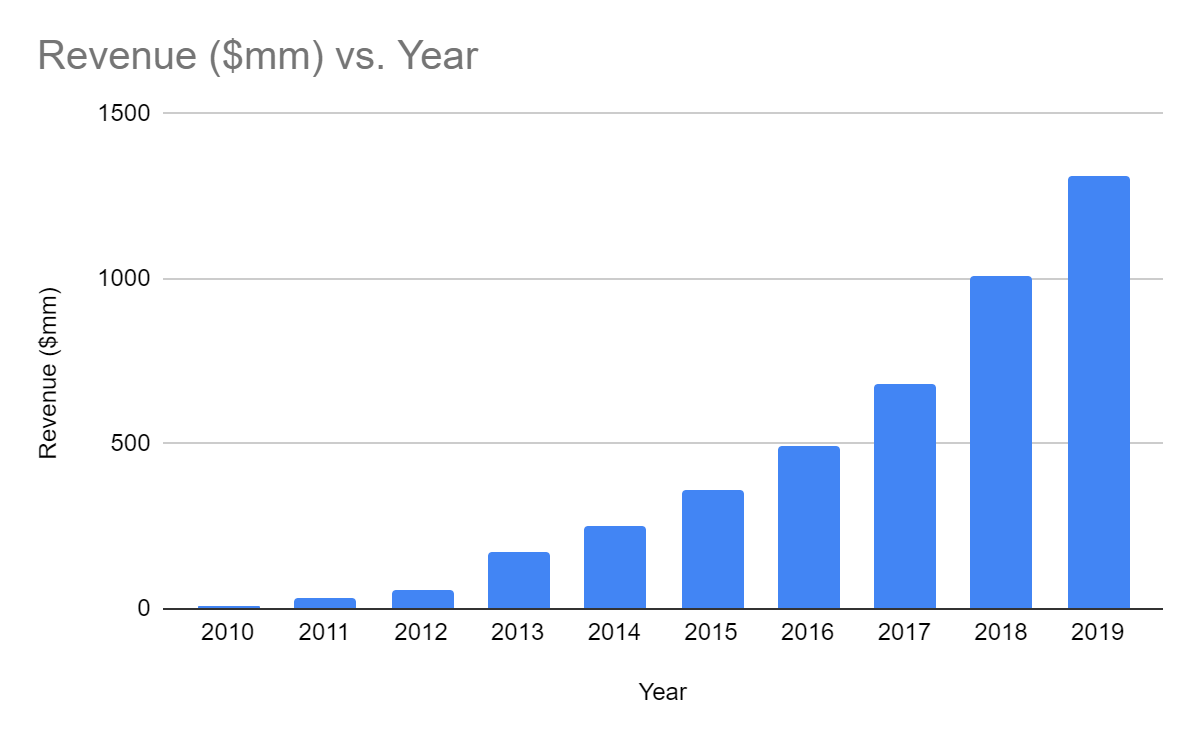
On the whole, Grubhub experienced substantial growth and expansion from 2010 to 2019, expanding its reach through acquisitions and partnerships and increasing turnover and user base. Here are some key reasons behind the continuous growth of Grubhub’s revenue.
- Grubhub focused on expanding its network of restaurant partners and expanding its geographic reach to more cities across the United States. This has allowed the company to attract more guests and generate more revenue from food delivery orders.
- Grubhub expanded its business by strategically acquiring other food delivery companies such as Seamless and Eat24. These acquisitions have allowed Grubhub to grow its user base and increase its revenue streams.
- Grubhub has invested in developing an easy-to-use technology platform for guests and restaurants. This made it easier for customers to place orders and for restaurants to manage their delivery operations, helping to increase order volume and sales.
- Grubhub partners with leading brands and companies to offer their customers shipping services such as Taco Bell and Yum! brand. These partnerships have provided Grubhub with additional revenue streams and helped increase its market visibility.
Grubhub experienced an increment in income amid the COVID-19 widespread, as more individuals requested nourishment conveyance administrations due to lockdowns and limitations on eating out.
Here is the graphical representation of revenue from 2020 and 2021.
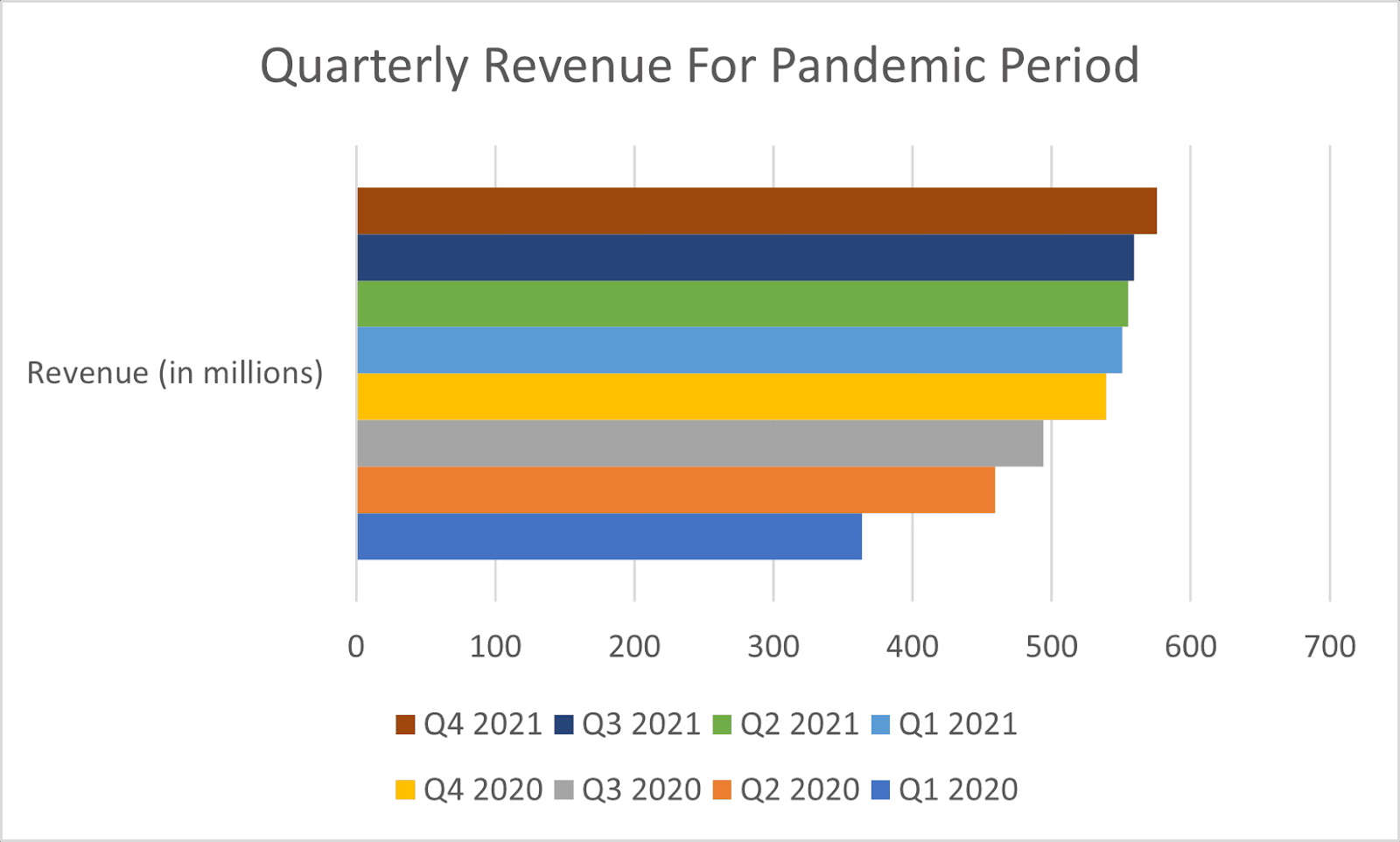
By 2020 the revenue of Grubhub grew steadily and showed a significant increase because of the pandemic impact. Moreover, It is worth noticing that Grubhub confronted expanded competition from other platforms this time. As we can see, in 2021 company’s revenue has remained stable with minor fluctuation. This is likely due to the continuous effect of a pandemic on food delivery services.
Apart from this, Grubhub heavily focuses on customer satisfaction. Indeed, customer satisfaction is an important factor affecting a company's financial performance, including revenue, profit and customer loyalty. To analyze customer satisfaction with Grubhub, we may consider several key factors that are important to customers, including order process, delivery time, food quality, customer service and overall experience [5].
- Many customers also appreciate the ease of platform navigation and order processing, earning Grubhub an overall rating of 4.2 out of 5 stars on Trustpilot [5].
- One of the key aspects of the food delivery experience is delivery time. Grubhub provides customers with real-time order tracking, allowing them to track delivery progress and predict delivery times [6]. However, delivery times may vary depending on a number of factors, such as restaurant location, traffic conditions and weather. Some customers have expressed dissatisfaction with delivery times, with Trustpilot reviews showing an average rating of 2.9 out of 5 stars for delivery speed [5].
- Food quality is another important factor affecting customer satisfaction. Grubhub is not directly responsible for the quality of food prepared by the restaurants with which Grubhub works, but they do provide customers with access to reviews and ratings that can help them make informed decisions. throughout the location of the order. According to Google Reviews, customers often rate Grubhub's food positively, with an average score of 3.9 out of 5 stars [7].
- Customer service is a key factor in customer satisfaction and Grubhub has multiple channels for customers to contact them, including phone, email and chat support. They also have a comprehensive FAQ section on their website that can help customers find answers to common questions [5].
Overall, Grubhub customers appear to be satisfied with their platform, with many praising the ease of use and convenience of the service. However, there are occasional complaints about delivery times, food quality and customer service [5]. To maintain customer satisfaction, Grubhub must continue to focus on improving these areas, as well as providing incentives, such as discounts or promotions, to retain and return customers [5].
Background and History of DoorDash:
DoorDash is a leading food delivery platform based in San Francisco, California. Tony Xu, Stanley Tang, Andy Fang and Evan Moore students of Stanford University founded DoorDash in 2013 as they were also frustrated with the limited choices for food delivery [9]. DoorDash launched as a food delivery service and its goal was to give multiple cuisine options from numerous restaurants. The firm quickly achieved popularity and expanded rapidly across the country [9].
The founders started DoorDash by personally delivering grocery orders to customers in their vehicles. Over time, the company grew and began employing its own drivers to meet the increasing demand for its services. Today, DoorDash operates in more than 4,000 cities in the United States, Canada and Australia, works with over 450,000 restaurants and delivers millions of orders daily [9].
The Company has designed its own logistic platform that works with machine learning algorithms to track the delivery routes and upgrade efficiency. DoorDash also introduced features like advanced ordering and real-time tracking. Moreover, DoorDash has also included services such as grocery and convenience delivery. In addition to food delivery, DoorDash has associated with local businesses to yield on-demand services like pet grooming and dry cleaning [9].
However, DoorDash has been criticized for its business practices, including the way it treats delivery partners and restaurant partners. The company has introduced new policies and partnerships with organizations to support fair labor practices [9].
According to a report by Edison Trends, DoorDash’s market share in the US grocery delivery industry increased from 17% in January 2018 to 32% in January 2019, Surpassing Uber Eats and Grubhub [9]. The company’s growth has continued throughout 2019, with its market share reaching 37% in October of this year.
DoorDash's rapid expansion can be attributed to a number of factors, including its ability to rapidly expand into new markets, partnerships with major restaurant chains and a desire to provide convenience and smoothness for customers [9]. However, the company has also been criticized for its treatment of delivery drivers and concerns about the company's profitability.
Growth and Financial Progress of DoorDash:
The company was founded in 2013 and is headquartered in Palo Alto, California. DoorDash has grown rapidly in recent years, with revenue growing from $0.11 billion in 2017 to $6.58 billion in 2022.
The Graphical Representation of DoorDash’s Revenue from 2017 to 2022:
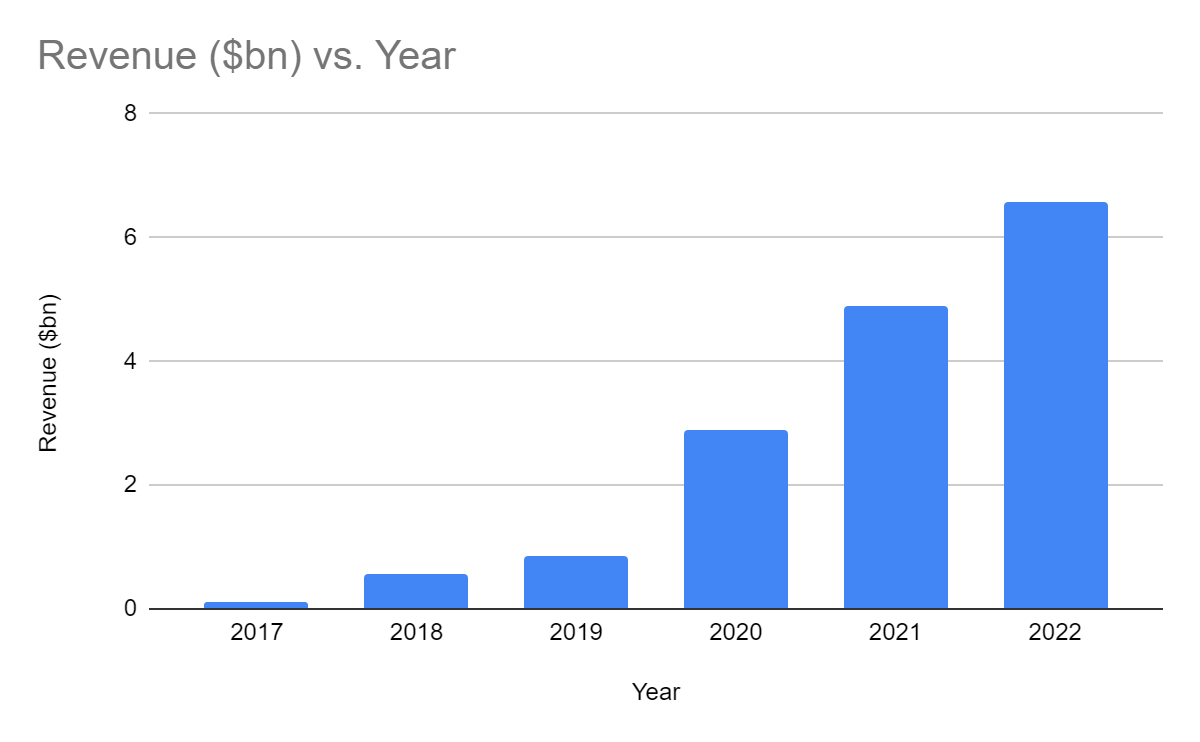
Here is a detailed description of DoorDash's revenue growth from 2017 to 2022:
DoorDash generated $0.11 billion in revenue in 2017, up slightly from the previous year. It's a sign that the company is on the right track as it shows that DoorDash can grow its business even in a competitive market.
There are a number of reasons why DoorDash was able to grow its business in 2017. First, the company focused on expanding its geographic reach. In 2017, DoorDash continued to expand rapidly, launching in more than 600 new cities and partnering with major restaurant chains such as Chipotle and The Cheesecake Factory [9].
DoorDash's revenue reached $0.55 billion in 2018. DoorDash's revenue growth in 2018 is an indication that the company is successfully pursuing its growth strategy. The company is expanding into new markets, focusing on improving the customer experience and investing in its technology. These factors have helped DoorDash increase sales and become a more successful business [9].
In 2019, DoorDash's revenue reached $0.85 billion. DoorDash's 2019 revenue growth was driven by a number of factors. DoorDash continues to focus on improving its customer experience in 2019. This includes faster delivery times, more accurate order information, and more payment options. Hence gain more customer ratings. Based on customer reviews and ratings on the company's website and other review sites, DoorDash has an average rating of 4.2 out of 5 stars.
By 2020, DoorDash's revenue reached $2.88 billion. The COVID-19 pandemic has led to an increase in demand for food delivery services as people are forced to stay at home and avoid going to restaurants. DoorDash has invested in innovation, which has helped the company improve the customer experience and attract new customers. For example, DoorDash has developed several new features that make it even easier for customers to order food, such as its DashPass subscription service.
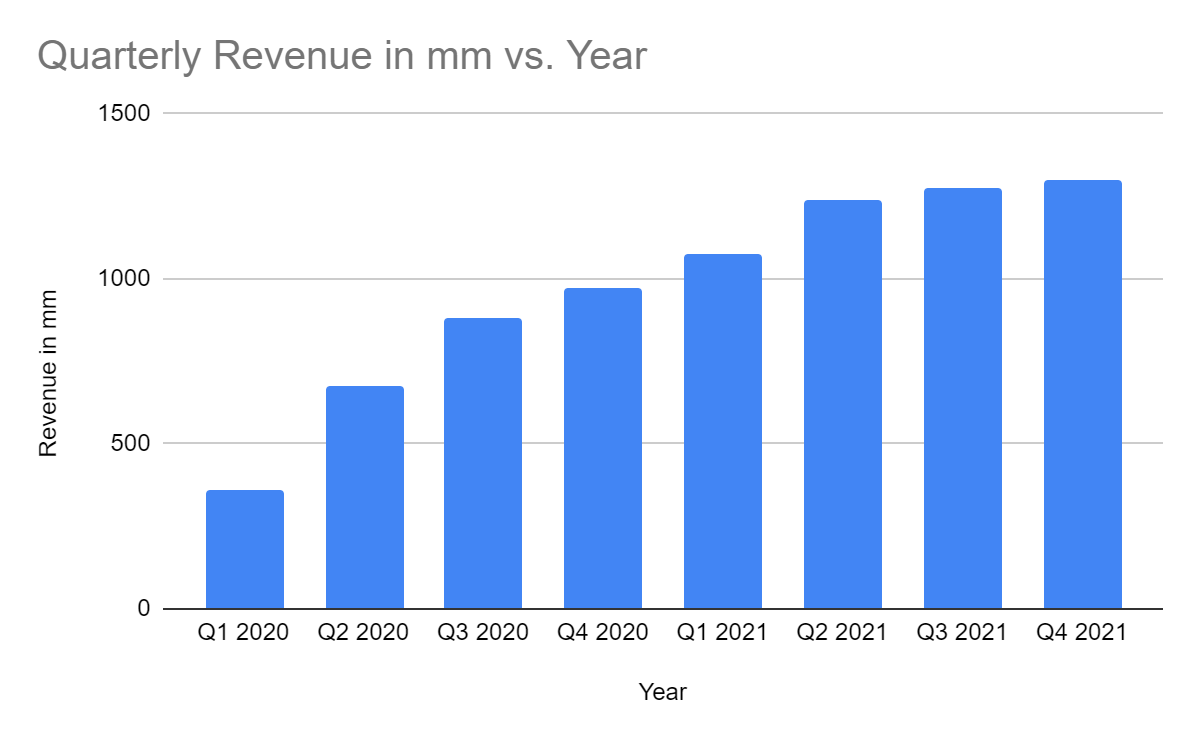
To read more about food delivery market share wars, join the CEO community.
SWOT Analysis of Grubhub:
Strengths of Grubhub:
- Strong brand identity:
Grubhub is an established brand with a high level of brand awareness and customer loyalty in the food delivery industry. Grubhub processes more than 715,000 orders per day and serves over 16 billion guests in nearly 2,000 metropolises in the United States and London. It's one of the top names in the online ordering order. [16].
- Extensive restaurant network:
Grubhub has over 3,65,000 restaurants that are spread each over the country. Throughout the times, Grubhub has many brands under its belt, including Tapingo and LevelUp. Both are original food delivery apps [16].
- Has its own delivery motorists:
Restaurants don't have to worry about paying someone to deliver their food to the guests. Grubhub hires people to work for them, so they can go to whatever job is demanded. They also train every person duly on how to do their jobs [16].
- Established Market Presence:
Grubhub has been in the food delivery business since 2004, giving it a significant advantage over new competitors. This has allowed Grubhub to establish a strong market presence and brand reputation [16].
Weakness of Grubhub:
- High commission fees:
Grubhub charges high commissions to its restaurant partners, which can be a financial burden for small businesses. This has led to criticism from some restaurant owners and operators, who say the fees are too high [16].
- Intense Competition:
Grubhub faces stiff competition from other food delivery platforms like DoorDash and Uber Eats, which can make it difficult to maintain market share and profitability [16].
- Dependance on Restaurants:
Grubhub's business model relies heavily on its restaurant partnerships. This dependence can make it vulnerable to upheavals in the restaurant industry, such as closings or changing consumer preferences [16].
Opportunities for Grubhub:
---
Threats:
---
SWOT Analysis of DoorDash:
Strengths of DoorDash:
- Market leader:
DoorDash is one of the market leaders in the food delivery industry with a strong presence in the United States, Canada and Australia. By 2021, DoorDash has a 58% share of the food delivery market in the United States [18].
- Strong Market Network:
DoorDash has partnerships with a wide range of restaurants, from fast food chains to high-end restaurants, providing customers with a wide range of options [18].
- Market Focus:
The brand has a particular focus on these markets to strengthen its network and meet customer needs with quality service. This will enable customers in these markets to order groceries from their favorite franchises, kitchens and restaurants. Customers can also place orders and pick up at stores, grocery stores and restaurants [18].
Weakness of DoorDash:
- Limited International Presence:
The brand currently operates in only three markets: the United States, Canada and Australia. Not only will this restriction prevent brands from offering services globally, it will also limit their ability to generate revenue on a global scale [18].
- Losses:
The brand has suffered huge losses since its founding in 2013. This can discourage investors and undermine the brand's ability to fund operations to ensure efficiency and effectiveness in service delivery. This can degrade a great customer experience and lead to customer dissatisfaction. Ultimately, this weakness causes brands to lose loyal customers, sales and further profits [18].
Opportunities for DoorDash:
---Threats:
---
SWOT Analysis of Uber Eats:
Strengths of Uber Eats:
- Financial support:
Financial backing is a strength of Uber Eats because it allows the company to invest in the business and grow. UberEats revenue reached $8.3 billion in 2021. Its revenue has grown rapidly over the past two years.
- Restaurant’s evaluation:
UberEats has its own star rating app just like Uber’s ride service which helps to know that restaurants are delivering without creating any issues. It helps customers make informed decisions, helps restaurants improve their service, and helps Uber Eats attract and retain customers.
- Delivery Services:
They provide fast delivery and customers get their food delivered within 10 minutes in 90 % orders.
Weakness of Uber Eats:
- High Commission Fees:
High fees for restaurants are a weakness for Uber Eats, as they can make it harder for restaurants to turn a profit. Uber Eats charges restaurants up to 30% commission on each order. This can be a huge financial loss for restaurants, especially small businesses.
There are a number of reasons why high commissions could be a weakness for Uber Eats. First, they can prevent restaurants from partnering with Uber Eats. If restaurants don't capitalize on their partnership with Uber Eats, they will be less likely to continue using the platform. This can lead to fewer food choices for customers
- Restaurants have limited availability:
UberEats restaurant selections may vary by location. In some areas, there may be a limited number of dining options, which Grubhubmay limit customer choice.
Opportunities for Uber Eats:
----Threats for Uber Eats:
To read more about food delivery market share wars, join the CEO community.
Potential threat for Grubhub and Doordash:
The decision to invest in a fast-food chain's own delivery team could affect the finances and brand for third-party delivery services like DoorDash and Grubhub.
Financially, the loss of customers by large fast food chains could lead to a significant drop in revenue from these delivery services. As more fast food chains develop their own delivery programs, they can reduce their reliance on third-party delivery services, which could lead to low demand for these services. than. In turn, this could lead to lower sales and profits for companies like DoorDash and Grubhub.
From a brand perspective,
---To read more about food delivery market share wars, join the CEO community.
Areas of Improvement for DoorDash and Grubhub:
Here is a table format with some possible areas where DoorDash and Grubhub can improve:
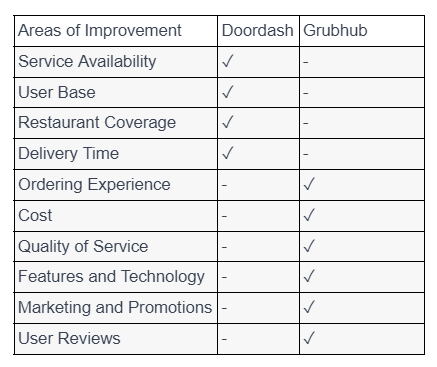
Grubhub has the potential to improve in the following areas:
- Marketing and Promotion:
DoorDash has the potential to improve in the following areas:
- Ordering experience:
To read more about food delivery market share wars, join the CEO community.
Amazon as Potential Future Competitor:
Amazon has 148.6 million Amazon Prime members in the United States. An increase of 49.05% from $99.7 million in 2017. Overall, the US accounts for 74% of all Amazon Prime subscriptions.
Here are some reasons why the number of Amazon Prime members in the US increased by 49.05%, from 99.7 million in 2017 to 148.6 million in 2023:
---
If Amazon launches its own food delivery service in the future, it might have some impact on Grubhub and DoorDash.
---To read more about food delivery market share wars, join the CEO community.
Amazon Prime Users and Their Use of Pharmacy and Food Delivery Services:
---Calculation for the number of Amazon Prime pharmacy users who signed up and ordered drugs in Q1, based on the 10% formula:
---
7-Eleven's Distribution Network: Value, Effectiveness, and Long-Term Benefits
---7-Eleven's delivery network is also very efficient. (7now.com) The company uses a centralized system to manage orders and track deliveries. This ensures that orders are delivered quickly and accurately.
The long-term benefits of 7-Eleven's distribution network are -----.
Dunkin Donut's Delivery Network: Expensive, Inefficient, and Not as Effective as 7-Eleven's
Value:
---
Effective:
---
Long term benefits:
---
Distribution network:
---
The Rise of Franchisees in the Food Delivery Industry: Exploring the Impact of 7-Eleven, Dunkin Donut and Beyond"
Franchisees like 7-Eleven and Dunkin' Donut launch their own food delivery services that could potentially affect third-party delivery platforms like Grubhub and DoorDash. Here are some potential impacts:
------
- 4.Increased competition:
The entry of established franchises into the food delivery firm will increase competition for Grubhub and DoorDash. Franchisees will have a recognized brand and customer base, which can drive customers away from third-party platforms.
---
Conclusion:
In a nutshell, Grubhub and DoorDash are two of the largest online food delivery platforms in the United States. The two companies have similar business models, generating revenue through commissions charged to partner restaurants for orders placed through their platforms. However, there are notable differences in their approach to last mile distribution and revenue diversification.
Grubhub, with its older presence in the market, is focused on providing an online platform for customers to order food from local restaurants, with delivery by the restaurant or the after-sales service provider. need to be provided by a third party.
---
Resources:
- Bhasin, Kim (February 22, 2012). "Grubhub's CEO On The Shock Of Outgrowing Three Offices In A Few Short Years".
Businessinsider.com. Retrieved October 2, 2013. - "Grubhub Secures $1.1 Million in Series A Funding From Top Venture Firms".
Prnewswire.com. November 13, 2007. Archived from the original on March 4, 2016. Retrieved November 14, 2016. - https://www.grubhub.com/
- https://www.businessofapps.com/data/grubhub-statistics/ ---
To read more about food delivery market share wars, join the CEO community.